Hydrangea: Planting, Transplanting – Care and Growing Guide (Pictures)
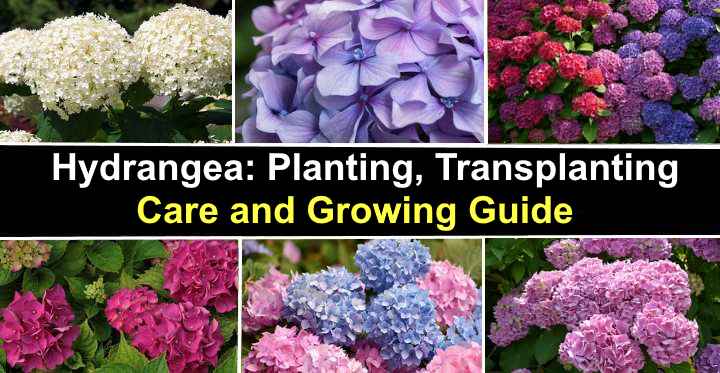
Hydrangea flowers are some of the largest, showiest, and most colorful blooms you can grow in a garden landscape. Beautiful hydrangea bushes fill gardens with dazzling, colorful flowers and lush green foliage from spring through summer and until fall. One of the beauties of planting hydrangea flowering shrubs is that they are easy to grow in gardens or backyards. Some stunning hydrangea bushes are dwarf shrub varieties that grow well in containers as patio plants.
Hydrangea Care Guide
The best place to plant hydrangeas to enjoy the flowers is in a partially shaded spot in your garden. As long as the ground has excellent drainage and the soil stays moist, hydrangeas are perennials that bloom throughout the summer. The only care that hydrangeas need to bloom regularly is some pruning in late summer, late winter, or early spring.
This article is a complete guide to caring for hydrangeas in a garden landscape. You’ll also find helpful advice on planting, transplanting, and watering hydrangeas to achieve the best results.
Hydrangea Bush — General Overview

Beautiful hydrangea shrubs add focal point to any landscaped garden
Hydrangea is a species of hardy flowering perennial shrub with large domed or flattened flower clusters. Most of the 75 species of hydrangea plants are deciduous bushes that lose their foliage every winter. Hydrangea shrubs grow between 3 and 10 ft. (1 – 3 m) tall and bloom in spring, summer, and fall.
Hydrangea Flowers: Hydrangeas are famous for their enormous flower heads and large leaves. Hydrangea flowers—called corymbs—grow between 4” and 14” (10 – 35 cm) across.
Hydrangea Leaves: Hydrangea leaves are ovate with a pointed tip and serrated margins. The leaves on hydrangeas can grow 6” (15 cm) long and 5” (15 cm) wide.
Perennial hydrangea shrubs come back year after year to bloom. Advice later in this article will help you know the best time to prune hydrangeas to keep them flowering year after year.
Types of Hydrangea Bushes
There are six main varieties of hydrangea shrubs. These hydrangea species are classified based on their flower or leaf shape and growth habit.
Here are the types of hydrangeas:
Bigleaf hydrangea (Hydrangea macrophylla)—The most popular garden hydrangea, famous for large mophead or pom-pom flowers. Some varieties also have flat flower clusters called lacecap flowers. Also called French hydrangea, the shrubs grow 4 ft. (1.2 m) tall and wide.
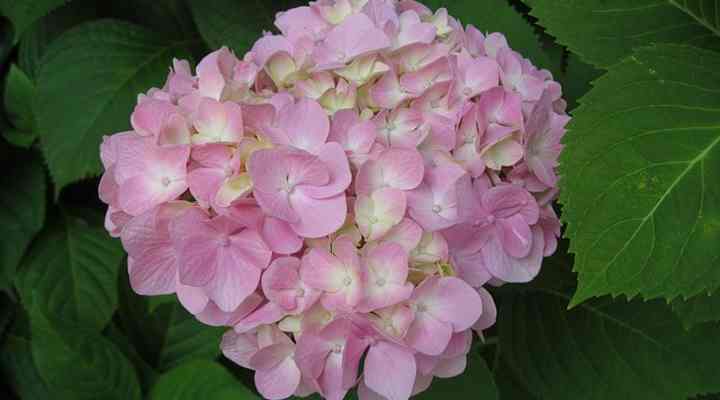
Bigleaf/Mophead hydrangea
Smooth hydrangea (Hydrangea arborescens)—Smooth hydrangeas grow 10 ft. (3 m) tall and 6 ft. (1.8 m) wide. The bushy plants have large white globular flowers like enormous snowballs.
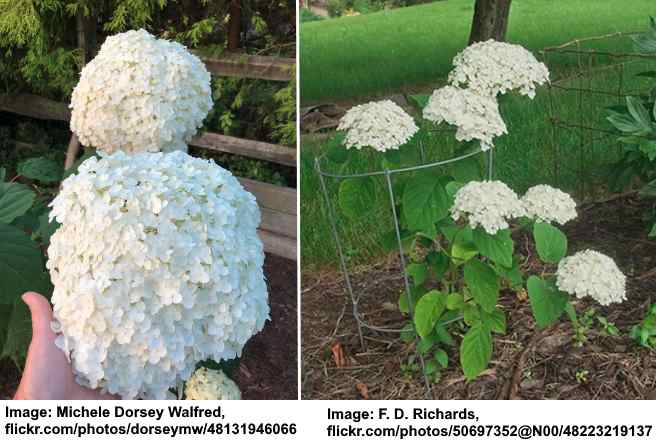
Hydrangea arborescens ‘Incrediball’
Panicle hydrangea (Hydrangea paniculata)—This hydrangea species is known for its cone-shaped flowers. Panicle hydrangeas grow between 3 and 16 ft. (1 – 5 m) tall and 8 ft. (2.5 m) wide.
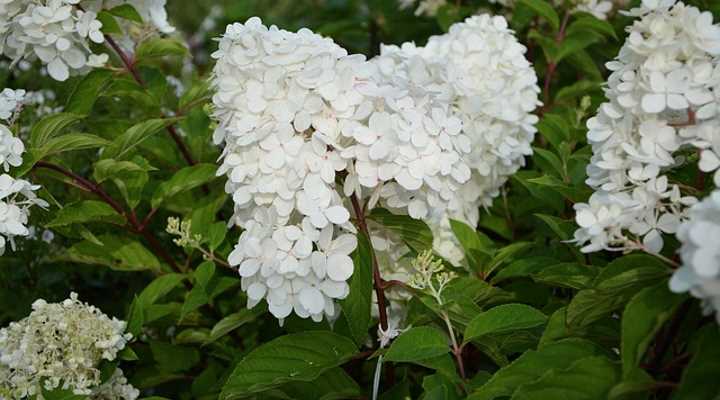
Panicle Hydrangea (Hydrangea paniculata)
Mountain hydrangea (Hydrangea serrata)—Popular hydrangeas due to their delicate lacecap flowers and shrubby, rounded growth of 4 ft. (1.2 m) tall and wide.
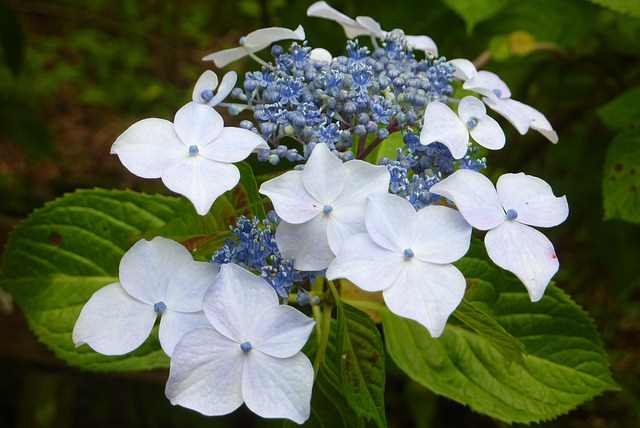
Mountain Hydrangea (Hydrangea serrata)
Oakleaf hydrangea (Hydrangea quercifolia)—The name of this hydrangea comes from its foliage resembling oak tree leaves. A feature of oakleaf hydrangeas is their huge cylindrical flowers growing up to 12” (30 cm) tall. Expect the hydrangea to grow between 3 and 12 ft. (1 – 3.6 m) tall.
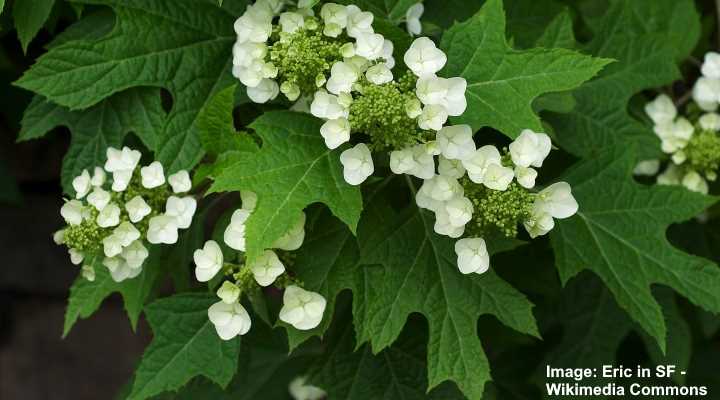
Oakleaf Hydrangea (Hydrangea quercifolia)
Climbing hydrangea (Hydrangea petiolaris)—The tallest hydrangea with growth up to 50 ft. (15 m) tall due to its long trailing vines. The flattened flower clusters on climbing hydrangeas grow up to 10” (25 cm) long.
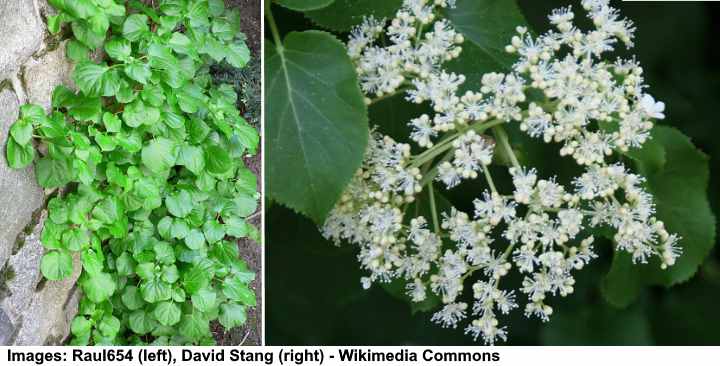
Hydrangea anomala subsp. petiolaris
Hydrangea Care: How Much Sun Do Hydrangeas Need?
Hydrangea bushes grow best in partial shade, where they get a maximum of six hours of sunlight daily. Ideally, plant a hydrangea shrub where it gets morning and afternoon sun but protection from intense midday sunshine. In colder zones, most hydrangeas perform well in full sun.
In hot, humid climates, hydrangeas do best in partial shade, getting two hours of direct sunlight. For example, trying to grow hydrangeas in Florida in full sun can lead to faded flower colors and wilting. For bigleaf hydrangeas and panicle hydrangeas to thrive in states such as Florida, plant the bushes in the shade.
Hydrangea Growing Zone
Generally, hydrangeas grow in USDA zones 3 through 9, depending on the cultivar. Some varieties of smooth hydrangeas and panicle hydrangeas are well-suited to zone 3. With extra protection from frost, most hydrangeas should be hardy enough for growing in zone 4.
The most popular varieties of hydrangea—bigleaf hydrangeas—are easy to grow in zones 5 to 9. However, in hotter climates, make sure the bushy shrubs are protected from the sun and get plenty of water during hot weather.
How Big do Hydrangeas Get?
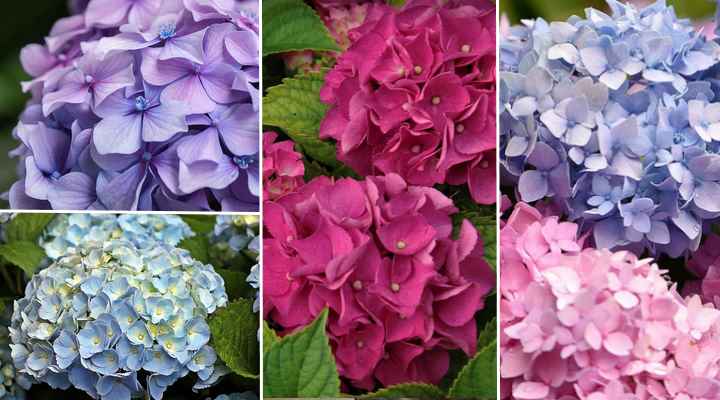
Bigleaf hydrangea generally grows 4 ft. (1.2 m) tall and wide.
Most types of landscape hydrangea shrubs grow as tall as they are wide. The ever-popular bigleaf hydrangea grows up to 4 ft. (3 m) tall and wide.
Here is a list of hydrangeas and how big they generally get:
- Bigleaf hydrangea: 4 – 10 ft. (1 – 3 m) high by 4 – 10 ft. (1.2 – 3 m) wide
- Panicle hydrangea: 3 – 16 ft. (1 – 5 m) high by 8 ft. (2.4 m) wide
- Smooth hydrangea: 3 – 12 ft. (1 – 3.6 m) high by 6 ft. (1.8 m) wide
- Oakleaf hydrangea: 12 ft. by 12 ft. (3.6 x 3.6 m)
- Mountain hydrangea: 4 ft. by 4 ft. (1.2 x 1.2 m)
- Climbing hydrangea: 50 ft. (15 m) high by 6 ft. (15 x 1.8 m) wide
Of course, there can be variations in the height and spread of individual hydrangea cultivars, with dwarf hydrangeas being noticeably smaller.
Most hydrangea species generally have a fast growth rate. Depending on the species, hydrangeas grow around 2 ft. (60 cm) a year until reaching their mature height. Planting hydrangeas in partial sun and keeping the soil moist is the best way to speed up growth.
Are Hydrangeas Deer Resistant?
Hydrangeas are relatively resistant to deer; however, they are not considered deer-proof. Generally, oakleaf hydrangeas and climbing hydrangeas are the most deer-resistant varieties. Although deer aren’t attracted to bigleaf hydrangeas or the other species, they may eat hydrangea leaves if there is nothing tastier to forage on.
Planting Hydrangea
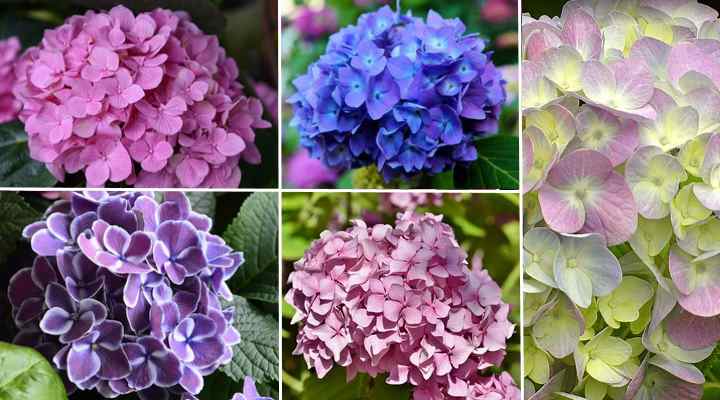
It’s best to plant hydrangea in early spring in partial shade, protected from the intense midday sun
Hydrangeas are typically easy to grow in most front or backyards. Their low maintenance makes hydrangea shrubs some of the most popular flowers for landscaping. However, the success of growing hydrangeas depends on planting them in the correct location.
Where to plant hydrangeas
The best place to plant a hydrangea is where it gets some protection from the midday sun. Ideally, choose a spot where the soil is fertile, rich in organic matter, and has excellent drainage.
If you suspect that too much sun or lack of it may be a problem, choose a suitable cultivar. Some panicle hydrangeas (Hydrangea paniculata) cultivars are ideal for growing in full sun.
When to plant hydrangea bushes
The best time to plant hydrangeas is in early spring after the risk of frost has passed. You can also plant hydrangeas in late fall before the first frost date. Whenever you plant a hydrangea shrub, avoid planting it in summer. The heat will damage its growth before it has a chance to get established.
Hydrangea spacing
Space hydrangeas depending on the spread of the plant. Generally, hydrangeas need to be spaced at least 3 ft. (1 m) apart. However, for large, spreading hydrangea bushes, you may need to give more room.
How to plant hydrangea shrubs in the ground
Preparing the ground well is the key to growing healthy hydrangea shrubs in your garden.
Before getting the soil ready, it’s good to know the type of hydrangea you will grow. The flower color on bigleaf hydrangeas depends on the acidity of the soil. In acidic soil, flowers will be blue, in alkaline, they will be pink.
To plant a hydrangea, get the ground ready by digging in organic matter. Dig a hole that is two to three times larger than the root ball. Set the hydrangea in the hole, making sure it’s slightly higher than it was in the nursery pot. Fill the remaining space with organically rich soil, press down, and water well.
A layer of mulch can help to lock moisture into the ground to keep the hydrangea roots healthy and prevent them from drying out.
How to plant hydrangea shrubs in pots
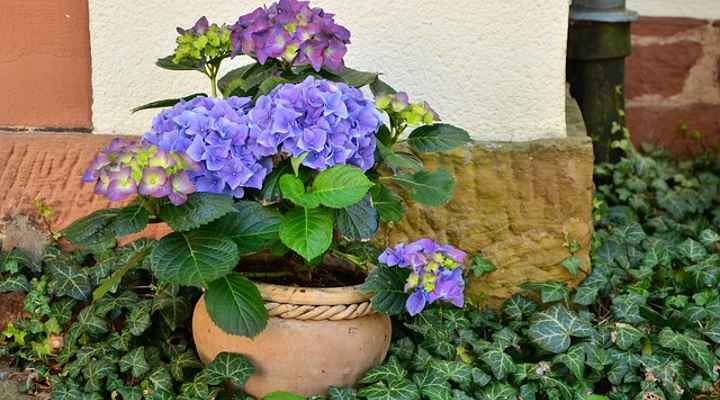
Potted hydrangea
Varieties of dwarf hydrangeas are ideal as patio plants growing in containers. Choose a sturdy container at least two feet (60 cm) wide and make sure it has drainage holes. Set the root ball in the pot and fill with a loose potting mix amended with perlite, gravel, or small stone chips for drainage. Water thoroughly.
It’s vital to keep the soil in the pot moist but never soggy to encourage healthy growth. Typically, you should water potted hydrangeas twice a week in the growing season. However, it’s crucial to remember that watering frequency depends on several factors, such as:
- Outdoor weather condition
- Size of planter
- Size of hydrangea
- Hydrangea cultivar
Hydrangea Care: Watering Hydrangeas in Gardens
Watering is an essential factor when growing hydrangeas in your garden. It’s usually necessary to give the hydrangea plants a deep watering once a week during the growing season. In especially hot, dry weather, watering three times a week may be needed.
Here are a few handy tips for watering hydrangeas:
- Ensure to water the ground without splashing water on the hydrangea leaves
- Watering in the morning helps to prevent hydrangeas from wilting in hot weather
- Never let the ground dry out because the hydrangea leaves and branches may start to droop
- Mulching around the hydrangea root base helps keep the soil moist and cool
Transplanting Hydrangeas
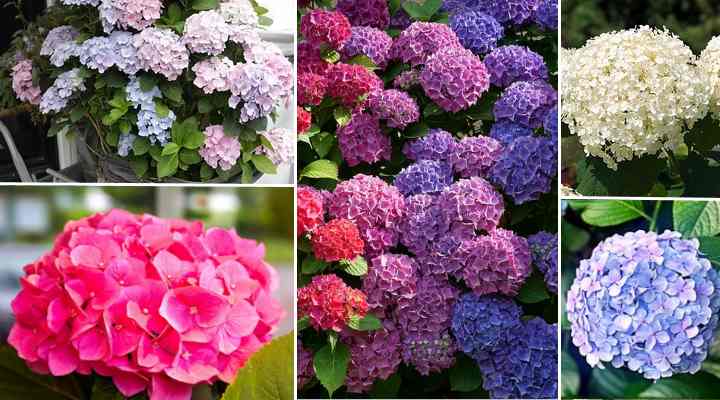
It’s best to transplant hydrangeas in the fall before the first frost when the plant is dormant
Moving a hydrangea shrub from one location to another may be necessary if it’s not growing well. Maybe there is too much sun during the day, or the bushes have spread and are too close together. You may also want to transfer a hydrangea from a container to plant in the ground.
When to transplant hydrangeas
The best time to transplant hydrangeas is in the fall, when the plant is dormant. The bush should look almost bare without any foliage. To ensure success, transfer the plant to the new location before the first frost. In areas with warm winters, you can transplant a hydrangea any time between December and February.
How to transplant hydrangeas
The first step to transplant a hydrangea is to dig a hole in the new location. Second, dig around the bush to free the plant’s root ball. Hydrangeas can have an extensive root system, so you may need help. Gently remove the hydrangea root ball from its existing location.
Plant the hydrangea bush in the new hole and fill the soil around it. Thoroughly water the root base. If transplanting a hydrangea in the fall, you don’t need to water it again until the spring. A transplanted hydrangea needs regular watering during its first growing season.
How to Grow Hydrangeas from Cuttings
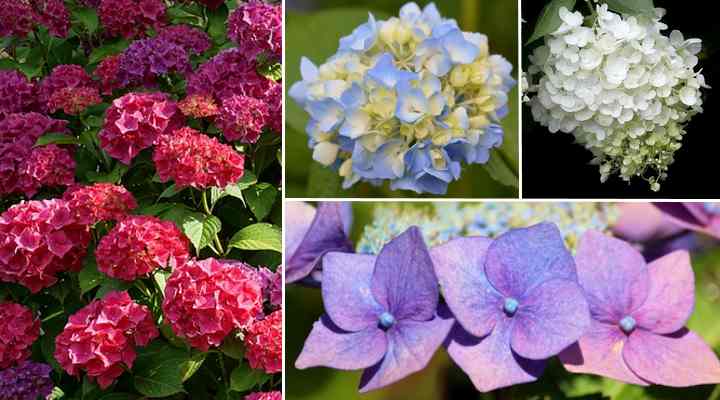
Hydrangea can be easily propagated by stem cuttings
To propagate a hydrangea bush, take new growth cuttings from a healthy plant in early summer. The cuttings should be at least 6” (15 cm) long and not have any flowers on them. Snip off the cutting just below a leaf node, ensuring there are 2-3 leaves on the cutting.
Put the cuttings in a pot with damp potting soil and cover them with a plastic bag. Put in a sheltered location, out of direct sunlight. Keep the soil moist. After about four weeks, the cutting should have roots, and new growth should start appearing on the stem.
You can then transfer to a larger pot and outdoors. Lightly cover with mulch in late fall to protect them from frost. In early spring, after the risk of frost, you can transfer the new hydrangea plant from its pot to a suitable location in your garden.
Alternatively, you can take stem cuttings in spring, root them in pots, and then plant the cuttings directly in your garden after four weeks.
Hydrangea Flower
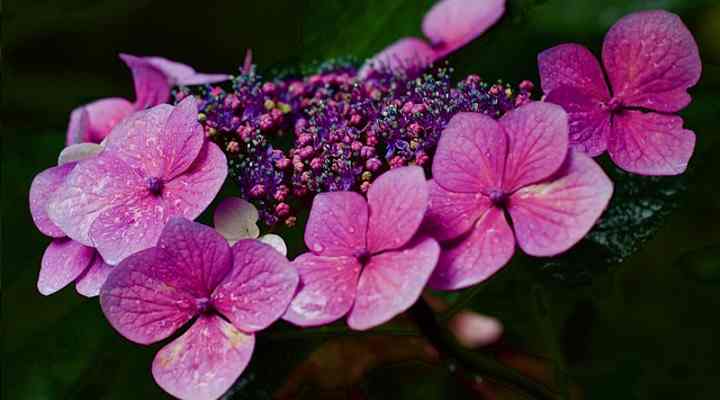
Lacecap hydrangea
Hydrangea shrubs are famous for their stunning floral display of large ball-like blooms. Hydrangea flowers can be shades of blue, pink, red, lilac, purple, chartreuse, white, and lime-green. Flowers on bigleaf hydrangeas and mountain hydrangeas also turn color depending on the soil acidity.
Hydrangea flower heads consist of two types of flowers—showy rounded globular flower clusters, and delicate flowers like tiny buds in the center and large 4- or 5-petaled flowers in a ring around the cluster of buds (lacecap hydrangea).
Most hydrangea cultivars bloom from late spring, throughout the summer until the fall.
The six varieties of hydrangeas grow four types of flowers:
- Mophead hydrangea flowers—Large pom-pom type flowers that grow on bigleaf hydrangeas and are generally pink, blue, or white.
- Lacecap flowers—The flower heads consist of a cluster of flower buds in the center, surrounded by showy flowers creating a delicate, lacy appearance. The flowers tend to be white and grow on climbing hydrangeas, some bigleaf hydrangeas, and mountain hydrangeas.
- Panicle flowers—Cone-like hydrangea flowers that grow on panicle hydrangeas and oakleaf hydrangeas. The flower colors can be white or pink or a combination of both colors.
- Snowball hydrangea flowers—As the name implies, snowball hydrangeas tend to be large globular clusters of white florets. Snowball flowers are common on smooth hydrangeas.
How to Change the Color of Hydrangea Flowers
Change the color of hydrangea flowers by altering the soil pH. Bigleaf hydrangeas—mophead and lacecap varieties—have blue flowers in acidic soil and pink flowers in alkaline soil.
Add organic compost (acidic) to get bigleaf hydrangeas to grow blue flowers. You can also try adding coffee grinds, crushed eggshells, and citrus peels to lower the soil’s pH level.
To turn mophead and lacecap hydrangeas pink, amend the soil with lime to make the ground more alkaline and raise the pH level.
Hydrangea Fertilizer
The best type of fertilizer for hydrangeas is an all-purpose, slow-release formula with an NPK rating of 10-10-10. You can also add an organic fertilizer consisting of sulfur, compost, and peat moss to help improve the health of hydrangea bushes. You can also buy a specially formulated fertilizer for hydrangea plants.
When and how to fertilize hydrangeas
The best time to fertilize hydrangea shrubs is in spring if you are using a slow-release fertilizer. This type of fertilizer provides enough nutrients to the roots throughout the growing season. If using organic matter, apply the fertilizer in March, May, and July.
When applying fertilizer, it’s crucial to spread it around the drip line of the shrub. This ensures that the hydrangea plant’s roots get an even amount of nutrients, and it helps prevent root burn.
Pruning Care for Hydrangeas
Pruning is an essential part of the general care for hydrangeas as it encourages healthy, bushy growth and prolific blooming. However, the time when to prune hydrangea plants requires knowing the type of hydrangea you have. Some hydrangeas grow flower buds on new wood, others on old wood.
When to Prune a Hydrangea
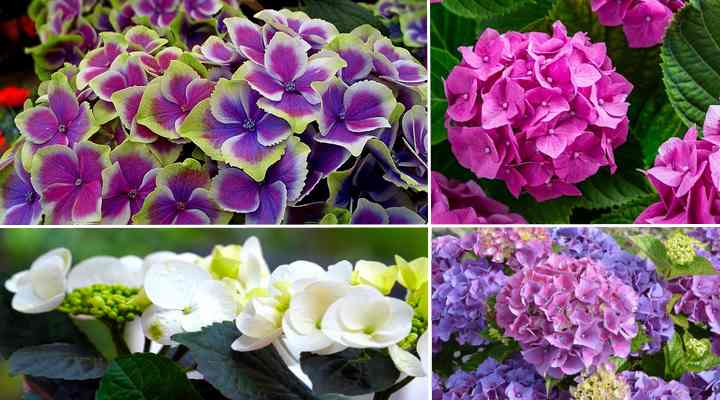
The time to prune hydrangea depends on the type of hydrangea, whether it grows flowers on new or old wood
The hydrangeas that bloom on old wood should be pruned in late summer. These are:
- Bigleaf hydrangeas (Hydrangea macrophylla)
- Mountain hydrangeas (Hydrangea serrata)
- Oakleaf hydrangeas (Hydrangea quercifolia)
- Climbing hydrangeas (Hydrangea petiolaris)
Hydrangeas that bloom on new wood should be pruned in late winter to early spring. These are:
- Panicle hydrangeas (Hydrangea paniculata)
- Smooth hydrangeas (Hydrangea arborescens)
How to prune hydrangeas
To prune hydrangeas that bloom on old wood, start cutting back the branches after the shrub finishes flowering. You only need to lightly trim stems to keep the shrub’s shape and remove dead branches. You can also prune branch tips in spring to encourage more smaller flowers to grow, rather than having fewer large flower heads.
To prune hydrangeas that bloom on new wood, cut branches back by one-third in late winter or early spring. Trim the stems just above the leaf node to encourage new growth.
If you have a smooth hydrangea, hard pruning will produce large flower heads. You can even cut the hydrangeas back to the ground. However, minimal pruning will encourage multiple flower heads that will be smaller.
Hydrangea Not Blooming – How to Get Hydrangea to Rebloom
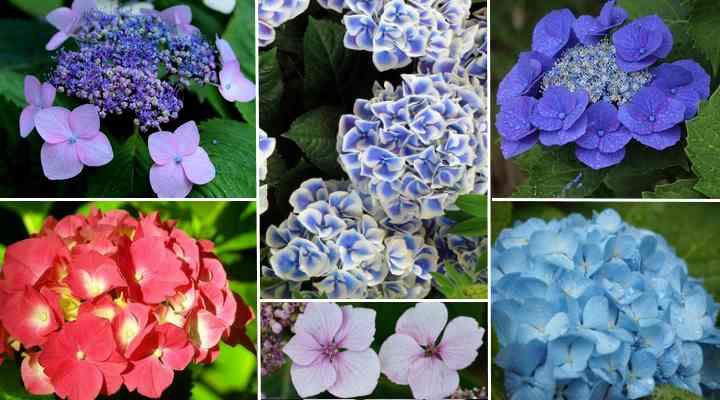
Bigleaf hydrangea blooms on old wood so protect the plant from frost to prevent it from dying in the winter
The most common reason for a hydrangea not blooming is that the bush dies back to the ground in winter. Bigleaf hydrangeas bloom on old wood. That means the growth from the previous year must survive the winter for the showy mophead flowers to bloom in spring.
Bigleaf hydrangeas may fail to bloom if you pruned back too much of the old, woody growth.
The solution to helping ensure that hydrangeas bloom every year is to protect the plants from frost during winter. Additionally, ensure that you prune bigleaf hydrangeas, oakleaf hydrangeas, and mountain hydrangeas in late summer.
Hydrangeas don’t rebloom in a single season. Unfortunately, deadheading hydrangeas flowers doesn’t encourage reblooming. On the other hand, hydrangeas tend to have a long blooming time, so you shouldn’t be too concerned about getting them to rebloom.
Pests and Diseases that Affect Hydrangea
Like most deciduous perennials, hydrangeas are affected by certain pests and foliage infections. Typically, caring for hydrangeas properly is the best way to ensure that healthy plants are resistant to disease and common garden bugs. Here is some helpful information on common issues affecting hydrangea growth.
Pest affecting hydrangea growth
Here is advice on getting rid of bugs that infest hydrangeas:
Aphids suck the sap from garden shrubs causing leaves to curl. You may also notice a sticky substance—honeydew—on leaves and a black, soot-like substance. To get rid of aphids, use your garden hose to blast the pest with a strong jet of water. Make sure to pay attention to the underside of leaves.
Slugs and beetles (rose chafers) munch their way through foliage and flowers. The best way to get rid of these pests naturally is to remove the beetles by hand or put down slug traps.
Diseases affecting hydrangea growth
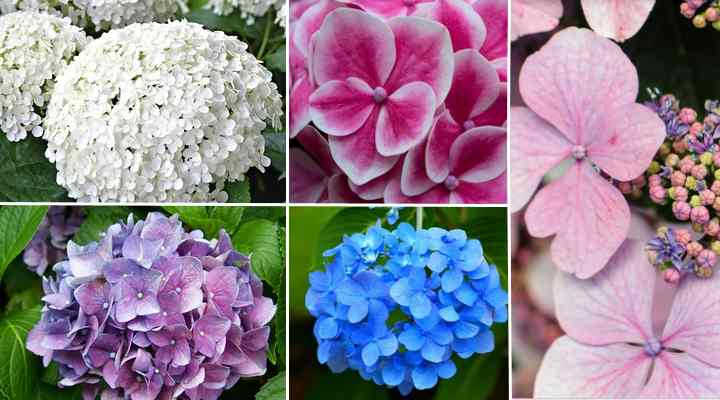
Over watering and lack of air circulation can cause powdery mildew or leaf spots on hydrangea shrubs
Here is advice on preventing diseases that can affect hydrangeas:
Powdery mildew forms a white, powdery substance on hydrangea leaves. This fungal infection is caused by a lack of air circulation or too much moisture on leaves—especially from watering incorrectly. Please read this article on how to treat powdery mildew to find out how to use milk, baking soda, or neem oil to treat the fungal disease.
Leaf spot caused by incorrect watering or poor air circulation can result in brown or black blotches on foliage. The best way to avoid this problem is to water hydrangea plants in the morning, and plant hydrangea bushes the correct distance apart.
Remember that hydrangeas thrive in well-draining soil that is constantly moist but never soggy. Overly damp ground can cause the roots to rot and slow down or damage hydrangea growth.
Hydrangea Toxicity
Hydrangea shrubs are poisonous for dogs, cats, and other animals. The ASPCA says that plants in the family Hydrangeaceae contain cyanogenic glycoside that causes vomiting, diarrhea, and depression if animals ingest the leaves.
Varieties of Hydrangea Bushes (With Pictures)
Hydrangea shrubs are among the most popular landscaping plants, thanks to their showy flower heads. Here are some of the most spectacular cultivars from the various species of hydrangeas:
Nikko Blue Hydrangea (Hydrangea macrophylla ‘Nikko Blue’)—The most popular hydrangea shrub is a mophead variety with large 5-inch (12-cm) flower heads. In alkaline soils, the flowers are pink, not blue. Grows 4 to 6 ft. (1.2 – 1.8 m) tall and wide.
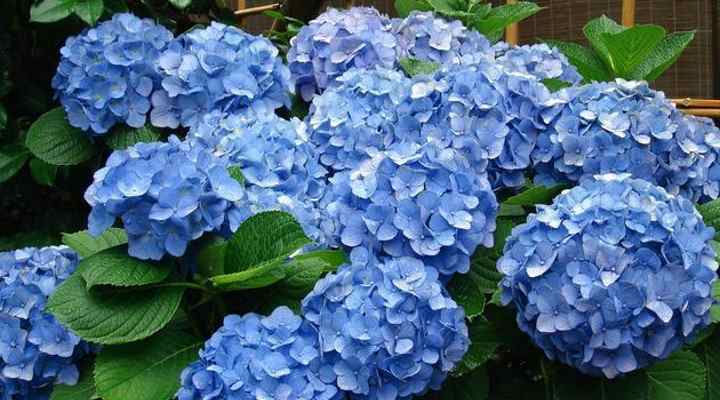
Hydrangea macrophylla ‘Nikko Blue’
Lacecap Hydrangea (Hydrangea macrophylla normalis)—Pretty flattened flower heads are the feature of the lacecap hydrangea. Large, lush green leaves contrast with the lilac and pink flowers. This bigleaf hydrangea grows 3 to 5 ft. (1 – 1.5 m) tall and wide.
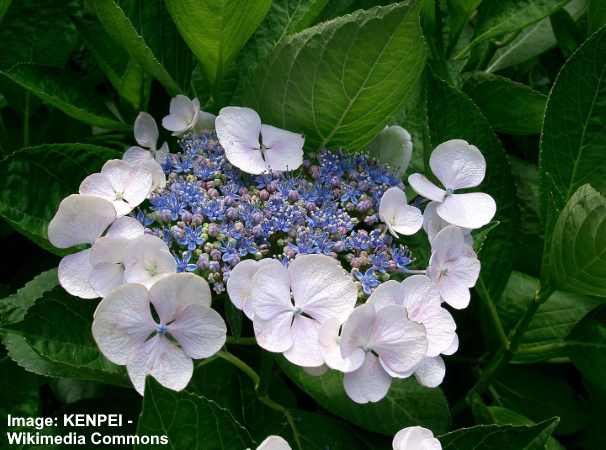
Hydrangea macrophylla normalis
Pee Gee Hydrangea (Hydrangea paniculata ‘Grandiflora’)—The ‘Pee Gee’ is a type of tree hydrangea with white conical flowers. The large shrubby hydrangea grows 10 to 20 ft. (3 – 6 m) tall and up to 15 ft. (4.5 m) wide
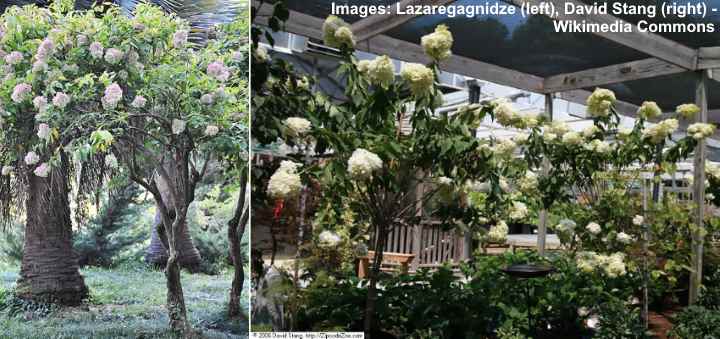
Pee Gee Hydrangea (Hydrangea paniculata ‘Grandiflora’)
Pink Hydrangea ‘Pinky Winky’ (Hydrangea paniculata ‘Pinky Winky’)—This panicle hydrangea has cone-shaped pink flowers growing on stiff stems. It grows 6 to 8 ft. (1.2 – 1.8 m) tall and 6 ft. (1.2 m) wide.
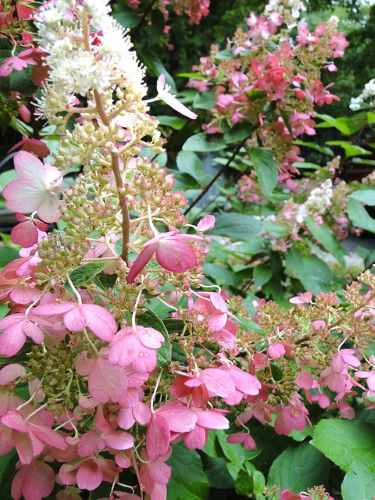
Hydrangea paniculata ‘Pinky Winky’
Annabelle Hydrangea (Hydrangea arborescens ‘Annabelle’)—The enormous snowball hydrangea flowers on this smooth hydrangea shrub grow 12” (30 cm) across. The beautifully rounded shrub grows 3 to 5 ft. (1 – 1.5 m) tall and 4 to 6 ft. (1.2 – 1.8 m) wide.

Hydrangea arborescens ‘Annabelle’
Landscaping with Hydrangeas
Hydrangeas have many uses in a garden landscape. You can grow the flowering shrubs as foundation plantings, flowering shrub borders, or decorative informal hedges and screens. You can also grow some cultivars as hydrangea trees.
Here are some ideas on planting hydrangeas in your front or backyard:
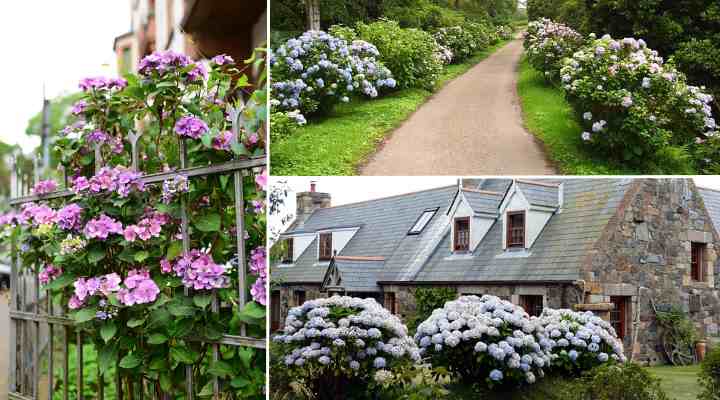
Hydrangea shrubs are great in landscaped gardens as informal borders, hedges and foundation plants for front of house
- The white cone-like hydrangea flowers on the ‘Limelight’ hydrangea (Hydrangea paniculata ‘Limelight’) create a beautiful romantic hedge.
- Plant blue or pink bigleaf hydrangeas (Hydrangea macrophylla) to add splashes of pastel colors to a bushy shrub border.
- Grow dwarf hydrangea bushes such as the bigleaf hydrangea ‘Masja’ (Hydrangea macrophylla ‘Masja’) as colorful foundation plantings for front of house.
- Small hydrangea bushes with pink, blue, or white mophead flowers look stunning when lining driveways, paths, or mixed flower beds.
- In a container garden or on a patio, dwarf hydrangeas growing in large pots make spectacular floral displays throughout the summer and fall.
- Grow a stunning hydrangea tree with sizeable white cone-like flowers by planting the ‘Pee Gee Hydrangea’ (Hydrangea paniculata ‘Grandiflora’) and removing suckers to allow a central stem to grow.
Related articles:
- Beautiful Types of Hydrangea Bushes
- The Best Foundation Shrubs for Front of House
- Small or Dwarf Flowering Shrubs for Your Garden
